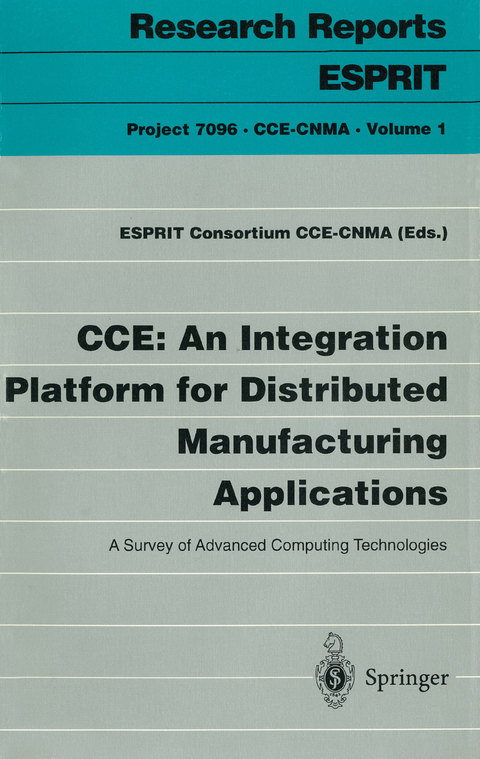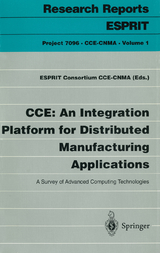CCE: An Integration Platform for Distributed Manufacturing Applications
Springer Berlin (Verlag)
978-3-540-59060-6 (ISBN)
1 Introduction.- 1.1 Origin of the project.- 1.2 History and evolution of the project.- 1.3. Who should read this book.- 1.4. Organisation of this book.- 1.5. How to read this book.- 1.6. Acknowledgements.- 2 The Problem of Integration in Manufacturing Applications.- 2.1 Introduction.- 2.2 Automation, communication and integration.- 2.3 Problems integrating applications in manufacturing.- 2.4 Partial solutions to the integration problem.- 2.5 The notion of application integration infrastructure.- 2.6 The CIMOSA approach to integration.- 2.7 Requirements for an information integration infrastructure.- 2.8 Summary.- 3 Architecture Overview.- 3.1 The CIME Computing Environment (CCE).- 3.2. The CCE-CNMA architecture.- 3.3 The components of the CCE-CNMA architecture.- 3.4 The CNMA communication architecture.- 3.5 Summary.- 4 Communication Services.- 4.1 Transport services.- 4.2 Transmission media.- 4.3 LAN access methods.- 4.4 LAN interconnection.- 4.5. Summary.- 5. Distribution Services.- 5.1. The client/server model.- 5.2. The producer/consumer model.- 5.3. OSI layers 5 to 7.- 5.4. Distributed computing: DCE and DDE.- 5.5. Object oriented technology: CORBA and OLE.- 5.6. Summary.- 6. Application Services.- 6.1. File access services.- 6.2. Messaging (electronic mail).- 6.3. Directory access services.- 6.4. Database access services.- 6.5. Transaction processing.- 6.6. Device access services.- 6.7. Fieldbus networks.- 6.8. Summary.- 7. Migration Tools.- 7.1. Introduction.- 7.2. Main features of the NIK.- 7.3. A Network Integrator at Work.- 7.4. Design of the Network Integrator.- 7.5. Summary.- 8. Network Management.- 8.1. Introduction.- 8.2. The Network Management Model.- 8.3. Architecture of the CNMA Network Manager Platform.- 8.4. Network Management Application Services.- 8.5. Benefits of using Network Management.- 8.6. Summary.- 9. The CIME Computing Environment (CCE).- 9.1. Overview of CCE.- 9.2. The CCE object model.- 9.3. CCE distribution mechanisms.- 9.4. Properties of CCE.- 9.5. CCE Execution environments.- 9.6. CCE services and Application Program Interfaces (APIs).- 9.7. Tools for CCE.- 9.8. CCE administration.- 9.9. Example: the Aérospatiale pilot.- 9.10. Summary.- 10. Relationships with Other Initiatives.- 10.1 Introduction.- 10.2. ESPRIT CIMOSA.- 10.3. ESPRIT COMANDOS.- 10.4. ESPRIT Delta-4.- 10.5. ESPRIT TT-CNMA and IT-CIM.- 10.6. ESPRIT FICIM.- 10.7. MAP.- 10.8. FAIS.- 10.9. Summary.- 11. Conclusions.- 11.1. The problems experienced by manufacturing enterprises.- 11.2. The problems with developing distributed manufacturing applications.- 11.3. So how can CCE-CNMA help to solve these problems?.- 11.4. Benefits of the CCE-CNMA technology.- 11.5. Industrial Achievements.- 11.6. So what of the future?.
| Erscheint lt. Verlag | 18.4.1995 |
|---|---|
| Reihe/Serie | Project 7096. CCE-CNMA | Research Reports Esprit |
| Zusatzinfo | XII, 207 p. 11 illus. |
| Verlagsort | Berlin |
| Sprache | englisch |
| Maße | 155 x 235 mm |
| Gewicht | 310 g |
| Themenwelt | Informatik ► Weitere Themen ► CAD-Programme |
| Schlagworte | Automation • CIM (Computer integrated manufacturing) • Communications Standards • computer-integrated manufacturing (CIM) • Computer Integrated Manufacturing (CIM) • Display • Distributed Computing • Hardcover, Softcover / Informatik, EDV/Anwendungs-Software • Kommunikationsstandards • Monitoring • Netzwerkverwaltung • Offenes System • Offene Systeme • Open System Environments • Verteilte Anwendungen • Verteilte Systeme • Verteilte Verarbeitung |
| ISBN-10 | 3-540-59060-9 / 3540590609 |
| ISBN-13 | 978-3-540-59060-6 / 9783540590606 |
| Zustand | Neuware |
| Haben Sie eine Frage zum Produkt? |
aus dem Bereich




